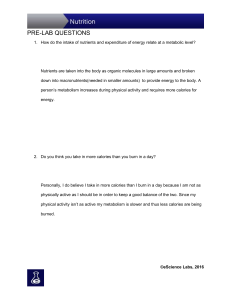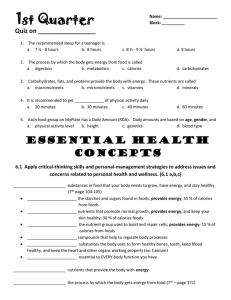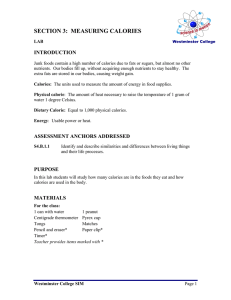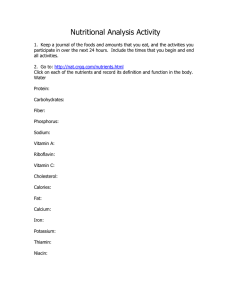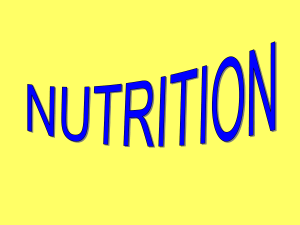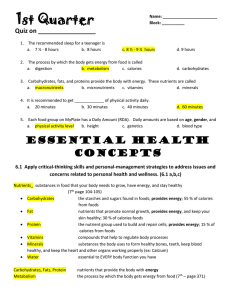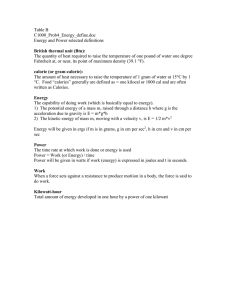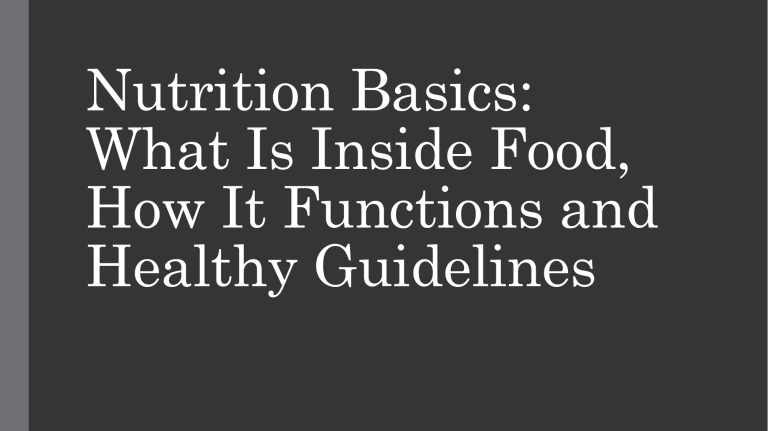
Nutrition Basics: What Is Inside Food, How It Functions and Healthy Guidelines INTRODUCTION: DIGESTING THE SCIENCE OF NUTRITION • Nutrition is more than just eating foods and drinking beverages. Nutrition is the science of how organisms take in and use food and drink for nourishment. • Food science is the study of the biological, chemical and physical properties of foods and their effects on the culinary, nutritional, sensory, storage and safety aspects of foods and beverages. • Cooking and baking are the processes of preparing foods and beverages for consumption by using various equipment, ingredients, methods and tools. • Cooking and baking utilize food science to influence the appeal, digestibility and satisfaction of foods and beverages—which, in turn, affect their nutritional values. What is nutrition, and why it is important in food science and culinary education? Nutrition, Nutritional Science and Nutrients • Nutrition is multifaceted. It is the sum of all of the processes in the consumption and utilization of foods and beverages. • Nutritional science examines how organisms consume and process foods and beverages for nourishment. • Nutrients, including carbohydrates, lipids, proteins, vitamins, minerals and water, are the essence of nutrition. They are also fundamental to ingredient and product development, cooking and baking. Nutrition, Nutritional Science and Nutrients • There are hundreds of chemicals in the foods and beverages for human consumption. Many of these chemicals are affected by cooking and baking. In addition, cooking and baking add other chemicals to our food supply and manipulate their structures and functions. • The impact of these chemicals on human nutrition cannot be understated. Nutrition, food science and culinary professionals need to keep current about rapidly evolving nutrient research and guidelines to create the healthiest products, recipes and menus. Nutrients and their functions pave the way. Essential, Energy-Yielding and NonEnergy-Yielding Nutrient • There are about 40 nutrients that are known to be essential for humans. • Essential nutrients are those that the human body cannot make on its own and must be supplied by the diet through foods and beverages. Essential nutrients are considered to be indispensable to life. • Non-essential nutrients can be made by the body, such as vitamin D synthesis when ultraviolet rays of sunlight strike the skin and vitamin K production from microorganisms that live in the digestive tract. Essential nutrients are considered to be indispensable to life. NORMAL NUTRITION • Normal nutrition is identified by what most people eat and drink under normal or ordinary circumstances. It accounts for everyday activities and the ability to stay healthy under reasonable conditions. • Nutrition guidelines and recommendations have been designed to qualify and quantify normal nutrition, including the average number of calories and amount of nutrients that most people need daily to stay healthy and prevent disease. UNDERNUTRITION • Undernutrition describes a condition whereby normal nutritional guidelines and recommendations are not met. It can result from inadequate food intake, poor absorption of nutrients or excessive loss of nutrients. • Undernutrition may or may not be accompanied by malnutrition, a medical condition that may be caused by an improper or inadequate diet. Malnutrition may be the consequence of disease, infection or starvation. • Poverty and food availability may lead to undernutrition and malnutrition. People who have access to food and choose not to eat it may become undernourished or malnourished, as in the case of eating disorders. OVERNUTRITION • Overnutrition is characterized by overeating or excessive intake of certain nutrients, such as carbohydrates and lipids. • Overnutrition may be caused by consuming too many calories compared to expending or burning too few calories through everyday activities and exercise. Obesity is an example of overnutrition, as is consuming excessive nutritional supplements over dietary needs. NUTRITION AND HEALTHY DIETS • The underlying factors of normal, under- and over-nutrition influence food and beverage choices. Nutrition, food science and culinary professionals can use these factors to help modify ingredients and techniques for healthier diets. • Normal nutrition is designed for most daily needs, many conditions affect normal consumption, such as business demands, busy lifestyles, illnesses, school, traveling and more. • People who are undernourished may require foods and beverages that are higher in calories and nutrients, while people who are overnourished may need to reduce their caloric intake, particularly certain nutrients. THE DEFINITION AND FUNCTIONS OF A HEALTHY DIET Simply put, a healthy diet is one that supports a person’s daily and long-term health and well-being. A healthy diet does the following: • Fuels the body with energy (calories) and nutrients for everyday activities • Provides additional energy and nutrients for recreational activities and sports • Supplies nutrients for growth, repair and maintenance • Fights disease • Cushions the body, protects it from accidents, regulates body temperature and heals • Sustains many different body systems as shown in Table 1-1 • Keeps these body systems functioning under many challenging circumstances throughout the life cycle What Is Inside Foods and Beverages? MACRONUTRIENTS, MICRONUTRIENTS AND NONNUTRIENT • Foods and beverages are filled with countless substances, from macronutrients, including carbohydrates, fats and oils, proteins, lipids and water that are needed by the body in “macro” or relatively large quantities, and micronutrients, including vitamins and minerals, that are needed by the body in “micro” or relatively smaller quantities. • Foods and beverages are also filled with non-nutrients, substances that may have some biological effects on the body, such as dietary fiber and phytochemicals, plant compounds with reportedly healthful benefits. • Foods and beverages also carry bacteria, microscopic organisms that can be either beneficial or harmful and potentially toxic substances that may find their way into our food supply. ESSENTIAL AND NONESSENTIAL NUTRIENTS • Essential nutrients are nutrients that the body cannot make or produce in sufficient quantities. Essential nutrients must be obtained through the diet. They include the building blocks of carbohydrates, lipids and proteins, certain vitamins and minerals, and water. • Nonessential nutrients can be made by the body or obtained from sources other than foods and beverages. These include biotin that is produced by gastrointestinal bacteria, cholesterol that is produced by the liver, vitamin K that is produced by intestinal bacteria, and vitamin D that is produced by sunlight. NUTRIENTS AND CALORIES • Nutrients provide energy, function, protection and structure, among many other roles in the human body. The energy-producing nutrients are carbohydrates, lipids (more commonly known as fats and oils) and proteins. • Energy is measured in calories. A calorie is a unit of energy that is often used when measuring the energy content of foods and beverages (dietary calories). A calorie is the amount of heat that is required to raise the temperature of 1 kilogram of water 1° Celsius (1.8 °Fahrenheit). • Calories are reported as small 1,000-calorie units called kilocalories (or Calories with an upper case “C”). Kilocalories are commonly abbreviated as kcal. FOOD BYTE • In everyday use, the terms calorie and kilocalorie are often used interchangeably, but this is incorrect. The term “kilo” means 1,000. One kilocalorie contains about 1,000 calories. Conversely, 1 calorie is the equivalent of 1,000th of a kilocalorie. One kilocalorie is equal to 1 Calorie (dietary calorie). In the example of 1 slice of whole-grain bread that contains 69 kcal or 69 Calories, this is the equivalent of about 69,000 calories! WHY CALORIES MATTER? • The calories per gram of carbohydrates, lipids and proteins are important to remember. They are used to calculate the number of calories per gram of foods and beverages. There are times, such as when reading food labels, that this information is helpful. Few foods and beverages contain only one nutrient; many contain a combination of carbohydrates, lipids and/or proteins. For example, 1 slice of whole-grain bread is not purely carbohydrates; 1(8-ounce) glass of dairy skim milk is not purely proteins, and 1 tablespoon of butter is not purely lipids (fat), contrary to some popular notions. In fact, 1 slice of whole-grain bread contains about 69 calories, of which about 44 calories are from carbohydrates, about 16 calories are from protein, and about 9 calories are from fats, as follows: 1 slice whole-grain bread = ~69 calories 11 grams carbohydrate × 4 calories per gram = 44 calories 4 grams protein × 4 calories per gram = 16 calories 1 gram fat × 9 calories per gram = 9 calories One (8-ounce) glass of dairy skim milk contains about 84 calories, of which about 48 calories are from carbohydrates, about 32 calories are from proteins, and about 2 calories are from fats, as follows: (8-ounce) glass dairy skim milk = ~84 calories 12 grams carbohydrate × 4 calories per gram = 48 calories 8 grams protein × 4 calories per gram = 32 calories .2 grams fat × 9 calories per gram = 2 calories How Food Works: Appetite, Hunger and Satiety (satisfaction) APPETITE Appetite is the psychological desire for foods or beverages. Many factors influence appetite, including sensory responses to the sights, sounds, smells and tastes of food. HUNGER Hunger includes a range of feelings that signal the need to eat. SATIETY OR SATISFACTION Satiety is the physical and psychological satisfaction that one acquires from consuming certain foods or beverages. FOOD CHOICES People make several food and beverage choices every day, thanks to a large extent to our global food supply. Not all of them are healthy. Designing healthy foods, using healthy ingredients and preparation techniques, and communicating the benefits of healthy foods may not drive their selection. Availability We tend to eat food that is easily available to match our fast-paced lifestyles. Eating locally and seasonally produced foods is becoming more popular. Familiar Foods We tend to choose familiar foods because they are comforting and/or safe. Familiar foods remind us of celebrations, family and traditions. Convenience We live in a busy world that keeps getting busier. The concept of a “family meal,” where family members gather to eat and discuss the day, is rapidly being replaced by eating on-the-run. Convenience and fast foods are fairly economical, handy and tasty. But foods and beverages such as these with instant taste gratification often come at a cost: more calories, fat, salt and sugar. While some cultures still place much value on the family meal, convenience and fast foods are creeping into their cuisines, too. Customs Some people eat raw foods because it is customary to their culture. Examples include sushi, a dietary staple in Japan, and steak tartare, a raw ground beef dish that is originally attributed to French cuisine Cost As natural resources become scarcer and food production and transportation costs multiply, consumer food costs continue to rise. This may prohibit people from choosing the optimal diet for good health. An economical diet may be filled with too many calories from fats and sugars (overnutrition), or it may not supply enough calories to thrive (undernutrition). Food Safety The foods we eat contain both beneficial and harmful bacteria. Beneficial bacteria, such as those found in cultured yogurt, supply healthy microorganisms to aid digestion. Harmful bacteria, such as those that accidentally creep into our food supply, may be deadly, as demonstrated by past E. coli (Escherichia coli) outbreaks in strawberries and beef. Religion People have selected or rejected foods and beverages for centuries because of their religious preferences. Some food practices are dictated by sacred writing and religious laws that instruct practitioners on which foods are healthy, religiously correct and/or safe. The Media Food choices are shaped by the media, including books, the Internet, magazines, newspapers, radio, television and social media, both consciously and subconsciously. NUTRITION OBJECTIVES FOR THE NATION: HEALTHY PEOPLE 2010 AND 2020 BASIC FOOD GROUPS The Basic Four Food Groups were introduced in 1956 to help classify foods based on their nutritional properties. 1. Dairy milk, 2. Meats, 3. Fruits and vegetables, and 4. Grain groups FOOD EXCHANGE SYSTEM In the food exchange system, foods and beverages can be substituted for one another with similar nutrients. The food exchange system was originally designed to help people manage diabetes and weight. It is also a useful tool for anyone who is interested in food selection and meal planning. THE USDA FOOD COMPOSITION TABLES AND DATABASES The USDA food composition databases (FCDBs) provide information about the nutritional composition of foods. Macronutrients, which are required in larger quantities and include carbohydrates, lipids and proteins, and micronutrients, which are required in smaller quantities and include vitamins and minerals, are provided. A sample food (macaroni and cheese) and its nutrients as shown in a food composition table is featured in Table 1-9. THE USDA FOOD GUIDE PYRAMID AND MYPYRAMID The Food Guide Pyramid was a recognizable nutrition tool that was introduced by the USDA in 1992. It was shaped like a pyramid to suggest that a person should eat more foods from the bottom of the pyramid and fewer foods and beverages from the top of the pyramid. Balance calories • Enjoy food, but eat less. • Avoid oversized portions. Foods to increase • Make half your plate fruits and vegetables. • Make at least half your grains whole grains. Switch to fat-free or low-fat (1%) dairy milk. Foods to reduce • Compare sodium in foods like soup, bread and frozen meals, and choose foods with lower numbers. • Drink water instead of sugary drinks. 10 Tips to a Great Plate are based on the US Dietary Guidelines for Americans, 2010 and offer the following advice [11,12]: 1. Balance calories. 2. Enjoy your food, but eat less. 3. Avoid oversized portions. 4. Foods to eat more often 5. Make half your plate fruits and vegetables. 6. Switch to fat-free or low-fat (1%) dairy milk. 7. Make half your grains whole grains. 8. Foods to eat less often 9. Compare sodium in foods. 10. Drink water instead of sugary drinks. FOOD EXCHANGE LISTS •A sample meal with food exchanges, calories, carbohydrates, protein and fats is illustrated in Table 1-11. It shows the importance of the types and amounts of nutrients in meal planning. In this otherwise low-fat meal, one can see that the fat calories in butter are significant. PORTION SIZES VERSUS SERVING SIZES A portion size is the amount of food that is consumed at one time, whether it is from a restaurant meal, can or package, or homemade recipe. In contrast, a serving size is the amount of food that is accounted for in the food exchange system and listed on a food label. The average serving sizes per serving that are consistent with the exchange lists are shown in Table 1-12. While they are particularly useful for diabetes and weight management, they represent the portion sizes that people should consume. Supersize was a trademark for the largest portion size available in meals offered by the fast-food giant McDonald’s. A smaller meal portion could be made larger by “supersizing” the meal. Example #1 demonstrates how the percentage of total calories from fat on a food label can be used to calculate the number of calories from fat in a food or beverage. Example #1: 1. Review the food label for the total number of calories and the percentage of total calories from fat. Total number of calories = 125 calories Percentage of total calories from fat = 30 percent 2. To determine how many calories of the food or beverage are from fat, multiply the total number of calories by the percentage of total calories from fat, expressed as a decimal. Solution: 125 calories (total number of calories) × .30 total fat (30 × .01) = 37.5 total calories from fat Example #2 demonstrates how to use a percentage to calculate the number of calories in a diet. Example #2: 1. If a person consumes 2,000 calories daily and requires a diet that is 30 percent total fat, how many calories of fat should he consume daily? Solution: 2,000 daily calories × .30 total fat (30 × .01) = 600 daily calories from fat Example #3: If 2,400 total calories are consumed daily and these calories contain 60 grams of total fat, then what is the percentage of total calories that is contributed by these grams of fat? Solution: 60 grams of total fat × 9 calories/gram of total fat (lipids) = 540 calories from total fat 540 calories from total fat/2,400 daily calories × .01 (to convert into a percentage) = 22.5 percent total fat Example #3 illustrates the importance of nutrient information such as this in ingredient, recipe, menu and diet development. Knowing how to calculate the percent of total fat is also useful in nutrition labeling. By becoming skillful with kitchen math, one may be able to compute decisive values and contribute missing links. NUTRITION FACTS PANEL • The Nutrition Facts Panel has been required on all food labels of US manufactured foods and food products since 1994. It is under US FDA regulation. The Nutrition Facts Panel must display mandatory nutrients for one standard serving of food or a food product. • Other nutrients do not have to appear if they are zero. Foods and food products that contain more than 5 grams are rounded to the nearest .5 gram. Foods and food products that are less than .5 gram are rounded to 0 grams. Foods and food products that claim to be classified as low-fat or high-fiber must be uniform with food and food products that bear similar labels . The Daily Values • The Daily Values (DVs) are a set of reference values that quantify the nutrients that appear within the Nutrition Facts Panel of US produced foods and food products. The DVs assist consumers and food and nutrition professionals in interpreting the amounts of these nutrients and comparing their nutritional values with similar foods and food products. • The DVs are established for adults and children age 4 and over based on a caloric intake of 2,000 calories, for adults and children four or more years of age. • The percentages of the Daily Values that appear on the Nutrition Facts Panel show what one serving of a food or food product supplies. Each nutrient is based on 100 percent of the daily requirements for that particular nutrient. According to Table 116, the Daily Value for sodium is 2,400 milligrams, about five times the amount of sodium in one serving of this food. This example demonstrates how the Daily Value can be used for food selection and meal planning. What Is a Healthy Diet? The ABCs of Healthy Eating • Now that the foundation of nutrition and its importance in food science and culinary arts have been established, along with the nutrition goals and regulations as established by US government, medical and scientific associations, it is time to turn our attention to the ABCs of healthy eating: adequacy, balance, moderation, calorie control plus moderation, and variety. These simple principles help to put a healthy diet into perspective. ADEQUACY • Adequacy is a measure of whether or not a diet meets the nutritional needs of generally healthy people according to the US DRIs. • Adequacy is determined and categorized by age, gender and life stage. A diet for a child is not adequate for a teenager and a diet for a teenager is not adequate for a pregnant woman or a senior. Extenuating circumstances, such as accidents and disease, may also affect the adequacy of a diet. BALANCE • Balance is an even distribution of the foods in a meal or the nutrients in a diet. • The human body seeks balance in many of its functions. For example, too little or too much protein is imbalanced and may lead to protein malnutrition or burden the kidneys. Similarly, a high-protein meal may be considered imbalanced if other nutrients are missing. CALORIE CONTROL • If a person follows the ABCs of healthy eating, then she should consume the right amount of calories. This assumes that the calories she consumes equal the calories she expends. Sedentary activities and labor-saving devices have reduced the calories that we expend, so people should eat less and practice calorie control to compensate. • A calorie-controlled meal provides about one-third of daily calories. A calorie-controlled diet may lead to weight loss over time. DISCRETIONARY CALORIES • Discretionary calories are the amount of calories that a person chooses whether or not to consume. • If a person requires 2,000 calories daily but consumes only 1,800 calories and meets their nutritional needs, then 200 calories are considered “discretionary.” EMPTY CALORIES • Empty calories refer to the calories in nutrientpoor foods and beverages, such as candy or soft drinks. • Empty calories still contain calories, but they may be devoid of nutrients and other health-enhancing substances such as fiber, minerals, protein and vitamins. For example, 15 jelly beans contain 159 calories, the majority of which are from sugar. One-quarter cup of raisins contains 122 calories. NUTRIENT DENSITY • The concept of nutrient density is virtually the opposite of empty calories. A nutrient-dense food is rich in nutrients compared to a calorie-dense food that is higher in calories. For example, a 1-cup serving of fresh broccoli contains about 30 calories. Broccoli is filled with calcium and magnesium; vitamins A, C, and K; and other nutrients. MODERATION • Moderation limitations. • is restraint without excesses or Moderation means consuming what is “just right” so a person is neither too full nor too hungry. •A moderate daily diet is satisfying and leaves room for discretionary calories. A moderate longterm diet may also be health-promoting. VARIETY • • Diets that are rich in fruits and vegetables provide all of the basic tastes: bitter (cruciferous vegetables), salty (seaweeds), sour (citrus fruits), sweet (ripe stone fruits) and umami (mushrooms and other fungi). Whole grains taste earthy, lean proteins taste meaty or mild (depending on their sources), and healthy fats taste light. By selecting a variety of foods such as these, a diet may be pleasing and beneficial. A variety-filled diet brings a daily array of nutrients and appetite for life. Digestion, Absorption, and Metabolism • Good nutrition depends on the proper digestion of foods and beverages and the normal absorption and metabolism of their nutrients. DIGESTION • Digestion is the process by which food and beverages are physically and chemically broken down into smaller components by the human body. These components are then absorbed and metabolized or stored for future use. Most foods and beverages undergo some form of digestion before they can be absorbed and used. Digestion in the Stomach • Foods and beverages are digested in the stomach, a pouch at the end of the esophagus. ABSORPTION • Once • food is digested, it is ready for absorption. Absorption is the movement of nutrients and other substances into the cells or tissues. METABOLISM • Metabolism is the sum of all of the physical and chemical processes by which energy is created and made available to the body. This energy can be used for such purposes as to build new body structures, including cells; heat the body; maintain or repair it; and provide energy for everyday activities and exercise. Factors That Affect Metabolism • Many factors affect the rate at which the body uses carbohydrates, lipids, and, to a lesser extent, proteins for energy. Some factors that raise the metabolism include caffeine, fever, growth, height, lean body mass, male gender, nicotine and stress. When a person is young, her metabolism is high. Also, tall, muscular men tend to have higher metabolisms than shorter and rounder women. • The factors that lower the metabolism include age, fasting, hormones, sleep and starvation. As a person ages, his or her metabolism decreases. This is similar to what occurs during severe dieting. The hormones that are produced by the thyroid gland may either increase or decrease the metabolism if they are too high or too low. How Cooking Affects Nutrition • A food can be more or less digestible depending on the type of food, the temperature to which the food is heated, and the time it takes to cook the food. This is because cooking begins the digestive process by physically and chemically breaking down nutrients. • Food processing may also influence the digestive process because it affects the bioavailability of certain nutrients. Some carbohydrate-containing foods, such as fruits and vegetables, can be consumed raw or they may only require partial cooking. More complex carbohydrates, such as the starches in grains and legumes, require longer cooking. How Cooking Affects Nutrition • Carbohydrates, some proteins may be consumed raw or partially cooked. • Raw fish in sushi, an uncooked egg in a Caesar salad, and raw ground beef in steak tartare are examples of protein in raw forms. • Lipids are commonly consumed without cooking. Consider the fats that are contained inside avocadoes, olives or nuts, or the oils that dress fresh salads. • Vitamins and minerals may be destroyed from overcooking. This is why many fruits and vegetables are better consumed raw or lightly cooked. Food as Medicine • In Greek and Roman times, food was considered more than nourishment; it served as elixirs or aids to stay healthy and prevent and manage disease. • Hippocrates, the Greek physician, connected the role of diet and disease. While some of his statements are not attributed to science, he did establish the possibilities of the nutrient-disease connection when he reportedly said, “Let food be thy medicine, and let medicine be thy food.” • Traditional Chinese diet, with its balance of yin (feminine) and yang (masculine) foods. According to the Chinese, an unbalanced diet could result in illness. Supposedly, excessive yin foods found in vegetables can lead to weakness, and excessive yang foods found in meat can lead to restlessness. • Herbs and spices have long been recognized for their ability to prevent, manage, and even cure some diseases. Thank you & Godbless!!!
